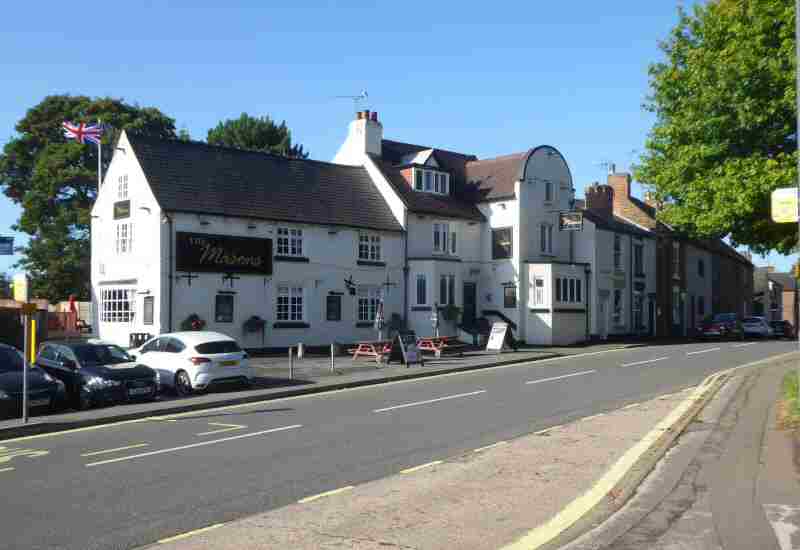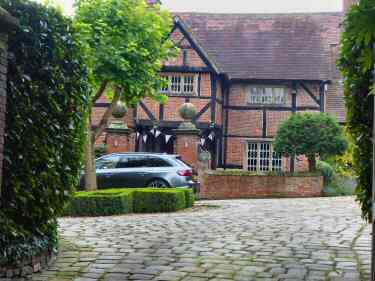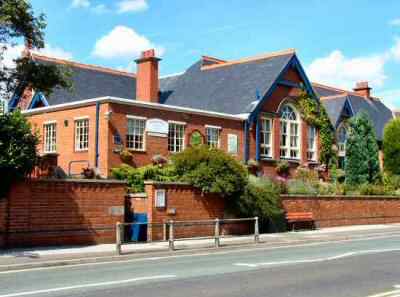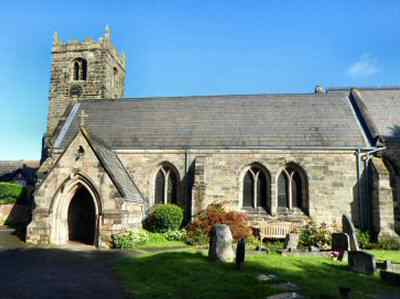MICKLEOVER

INFORMATION
Where is it? – On the B5020 Uttoxeter Road about 4 miles from Derby City Centre (SK).
What to do? – Take a stroll around the Conservation Area; enjoy a walk or a cycle ride down the former trackbed of the Great Northern Line which has been resurfaced for public use and is referred to as the Mickleover Railway Walk (Cycle). It takes you along the beautifully restored railway line and forms part of the National Cycle Network (Route 68). The Great Northern pub on Station Road, Mickleover is a starting point for many walkers and cyclists on this easy seven-mile journey (3.5 miles each way);
try something different and go on a day Mickleover Sports FC are playing a home match. The club at the time of writing are currently a member of the Northern Premier League Premier Division and plays at their Station Road ground.
Where to eat? – There are several pubs and restaurants in Mickleover to choose from; the award-winning Old School Tearooms at the Community Centre are run by a team of volunteers and welcome both existing and new customers. For further information visit: The Old School Tea Rooms – Mickleover Community Centre (mickcc.org.uk) or telephone 01332 510726.
Other places to visit
Derby Cathedral is a superb place to visit with its impressive Perpendicular Tower. The second-highest in England to the Boston Stump. The Cathedral Centre on the opposite side of the road holds some of the Cathedral’s treasures – Kedleston Hall is one of the best surviving examples anywhere of the work of Robert Adam. And is now in the hands of the National Trust. It is lavishly decorated with fine collections of paintings, furniture and sculptures. The marble hall has been described as ‘one of the most magnificent apartments of the 18th century in England’ – Markeaton Park attracts more than one million visitors each year. With its very popular amusements for children and special events. A craft village now occupies what were once Markeaton Hall stables. The area has been extensively restored with the benefit of a Heritage Lottery grant.


PROFILE
Mickleover is a largely residential suburb of Derby. It is located on the western outskirts of the city. Most of the development there took place during the 20th century. But in an area close to Uttoxeter Road are several interesting old buildings of such historical importance that in 1975 Conservation Area status was awarded.
Mickleover was settled by the Saxons, and probably by the Romans before then. The discovery of a large number of Roman coins in 1988, when a school extension was being built, added weight to that theory. In addition, Ryknield Street, constructed by the Romans, ran through Littleover. Only a short distance away, on the other side of Mickleover Moor.
Before the Norman invasion, Mickleover was a royal manor. But William the Conqueror gave it, together with Littleover, Findern and Potlock, a now deserted medieval village, to the Abbots of Burton Abbey. Life was difficult under the Abbots with several serious disputes about taxes. Following the Dissolution of the Monasteries, the manor of Mickleover was granted to Sir William Paget, by Henry VIII. Over the next few centuries, it changed hands several times.

Industrialisation
The rapid expansion of industrialisation in Derby during the 18th and 19th centuries led to overcrowding in the centre of the town. This resulted in the better off starting to look further afield. It seemed ideal for their requirements. to build their mansions and Mickleover
Despite the rapid expansion of Mickleover in the 20th century, Derby did not absorb the village until 1968. This meant that it was rather inconvenient for those who lived on the western side of the village. The Uttoxeter Trolley bus service and, for a short time, the motorbus service that took its place, only ran as far as the Borough boundary. The boundary extension solved this problem and Corporation buses no longer stopped short of the village centre.
The Great Northern Railway
The Great Northern Railway built a station, on their Ilkeston to Egginton line, in the late 1870s. It was about one mile from the centre of the Mickleover, in a cutting-off Mackworth Road, now Station Road. The main purpose of the line was to carry freight, with a limited passenger service also available. At Egginton Junction, it joined the Derby to Crewe line.
The service did not have a particularly long life, closing for regular passenger trains in 1939 along with Egginton Junction and Etwall Station, following the withdrawal of LNER services to Burton-upon-Trent. Excursion trains continued to call for several years, before total closure on 3 February 1964. The line itself remained open as a test track but cutbacks in research and the building of the Etwall by-pass led to its closure. Great Northern Inn and the station buildings remain as a reminder.
Pastures Hospital
In 1851, the Derbyshire Pauper Lunatic Asylum, later known as Pastures Hospital, opened; patients came from Union Workhouses all over the county. Many of them had been kept in atrocious conditions. Once freed of chains and restraints they found that not only were they given proper care and attention, but also that there were opportunities for recreation and relaxation amidst beautiful countryside. Many of the men worked on the hospital farm and the women attended to domestic jobs. The hospital closed in the late 20th century and the land is now taken up by housing.
In 1851, Derbyshire Pauper Lunatic Asylum opened on the western edge of Mickleover. It later became known as Pastures Hospital. The original estate covered an area of 79 acres with 32 acres enclosed by a brick wall nearly a mile long. Patients came from Union Workhouses all over the county, many of them having been kept in atrocious conditions. Once freed of chains and restraints they found that not only were they given proper care and attention. But also that there were opportunities for recreation and relaxation amidst beautiful countryside. Many of the men worked on the hospital farm and the women attended to domestic jobs. The hospital closed in the late 20th century and the land is now taken up by housing.
Community Centre
Mickleover Board School for boys and girls was erected on Uttoxeter Road in 1880. It accommodated 250 pupils of all ages and adequately met the educational requirements of all the children in the village. Since then the population of Mickleover has increased enormously and the children are accommodated in several schools around the area. It has now been converted into a successful Community Centre and received several awards in the past as the best in Derby. There is an excellent tearoom, staffed by volunteers, that serves morning coffee and light lunches for both local people and visitors alike.
Cinema Event

An unusual event occurred at Mickleover Board School on Wednesday 7 February 1900. When the first children’s matinee in British cinema took place on the premises. The matinee preceded a film for adults. Exactly why the show took place at Mickleover, which never had a cinema, is not known. There is no record of any further shows being held. It was more than ten years later before Derby had its first purpose-built cinema and sometime after that before regular children’s matinees were shown.
Conservation Area
The Conservation Area was designated in March 1975. Despite this growth, the original street pattern and several of the village’s more prominent buildings remain. Despite Mickleover’s rapid expansion, the original street pattern and several of the former village’s more prominent buildings remain. Next to All Saints Church on Uttoxeter Road, is the Old Manor House, built for Major Newton’s personal use in 1849. It has also seen service as a school and hospital. The Old Hall is a delightful timber-framed house in Orchard Street, where legend has it that Oliver Cromwell stayed when he stormed Tutbury Castle. The Green that leads off Orchard Street contains several early 19th-century cottages, on the corner of which is Ivy House, a private residential home. The Old Hollow Cottage in The Hollow is a fine old timber-framed cottage that once had a thatched roof. The Limes, built-in 1836, is a large white 19th-century villa that stands on its grounds over-looking fields. The Limes was built around 1836, for Samuel Wright, a wealthy local businessman, who was a silk throwster. It was and still is, a handsome mansion with a lovely conservatory and good field views.
The Square was previously called the marketplace, in the days when Mickleover was only a small village. It was used to stage the Annual Wakes, Plough Monday and the Harvest Festival when Mickleover was a predominantly farming community. The Market Place was also a stopping place for horse-drawn transport. In the 1800s, a coach passed through the village en route to Newcastle-under-Lyme, three days per week, returning on the following day.
All Saints’ Church
William the Conqueror is recorded as giving the town of Mickleover, with its church, to Burton Abbey, but there is no mention of a church in the Domesday Book. The present church has early 14th-century origins, but mainly dates from 1858. At that time it underwent extensive restoration by H. I. Stevens. A clock with only two faces was installed in the tower by John Smith in 1895; with open fields to the north and east, no more was required. Further works were carried out during the 20th century, including the provision of a Lady Chapel, consecrated in June 1967. The crypt was discovered by the verger when he fell five feet down into it. After the slab that was covering the entrance cracked and broke into two pieces.



